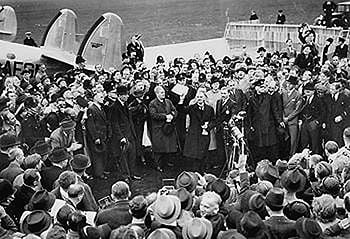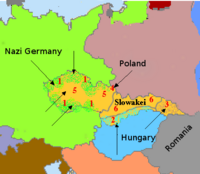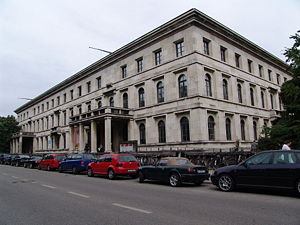Munich Agreement
| This article is part of the series: Territorial changes of Germany |
|---|
| Background |
| German settlement in Eastern Europe |
| Unification of Germany |
| World War I |
| Treaty of Versailles |
| Silesian Uprisings |
| Polish corridor |
| Interbellum |
| Return of the Saar region |
| Rhineland Remilitarization |
| Anschluss (Austria) |
| Munich Agreement |
| World War II |
| Großdeutschland |
| Polish areas annexed by Nazi Germany |
| Yalta Conference |
| Potsdam Conference |
| Post-World War II |
| Former eastern territories of Germany |
| Territorial changes & Oder-Neisse line |
| Treaty of Zgorzelec (1950) |
| Treaty of Warsaw (1970) |
| Treaty of Prague (1973) |
| 2+4 Treaty (1990) |
| German-Polish Border Treaty (1990) |
| See also |
| Territorial changes of Poland |
| Recovered Territories |
The Munich Agreement (Czech: Mnichovská dohoda; Slovak: Mníchovská dohoda; German: Münchner Abkommen) was an agreement regarding the Sudetenland Crisis among the major powers of Europe after a conference held in Munich, Germany, in 1938, and signed on September 30. The purpose of the conference was to discuss the future of Czechoslovakia in the face of territorial demands made by German dictator Adolf Hitler. The agreement, signed by Nazi Germany, France, Britain, and Italy, permitted German annexation of Czechoslovakia's Sudetenland. The Sudetenland was of immense strategic importance to Czechoslovakia, as most of its border defenses were situated there.
Because Czechoslovakia was not invited to the conference, the Munich Agreement is commonly called the Munich Dictate by Czechs and Slovaks (Czech: Mnichovský diktát; Slovak: Mníchovský diktát). The phrase "Munich betrayal" (Czech: Mnichovská zrada; Slovak: Mníchovská zrada) is also frequently used because military alliances between Czechoslovakia and France were not honored.
Background
The Sudetenland was an area of Czechoslovakia where ethnic Germans formed a majority of the population. The Sudeten Germans had attempted to prevent the German-language border areas that had formerly been part of the Austro-Hungarian Empire from becoming part of Czechoslovakia in 1918. They had proclaimed the German-Austrian province Sudetenland in October 1918, voting to join the newly declared Republic of German Austria in November 1918. This had been forbidden by the victorious allied powers of the First World War (the Treaty of Saint-Germain) and by the Czechoslovak government, partly with force of arms in 1919. Many Sudeten Germans rejected affiliation with Czechoslovakia because they had been refused the right to self-determination promised by U.S. president Woodrow Wilson in his Fourteen Points of January 1918. The Sudetenland became part of Czechoslovakia due to the fact it had always formed part of the Kingdom of Bohemia, which was the main portion of Czechoslovakia and many German-speakers felt themselves to be German-speaking Czechoslovaks rather than Germans or Austrians living in Czechoslovakia.
Hitler's demands

In March 1938, Germany had annexed Austria with the Anschluss. It was widely expected that Czechoslovakia's Sudetenland, with its substantial German population led by the Nazi politician Konrad Henlein, would be Hitler's next demand. Indeed, as Hitler increasingly gave inflammatory speeches demanding that the German minority in Czechoslovakia be reunited with their homeland, war seemed more and more likely. Many thought war was inevitable and that a peace agreement that would satisfy everyone would be impossible to attain.
The Czechoslovaks were counting on political and military assistance from the French government, as they had an alliance with France. France, under the leadership of Édouard Daladier, was nonetheless unprepared militarily and politically for war, and the French government was dedicated to solving the crisis without entering a state of war. Czechoslovakia also had a treaty with the Soviet Union, and Stalin indicated willingness to cooperate with France and Great Britain if they decided to come to Czechoslovakia's defense.
None of the powers in western Europe wanted war. They severely overestimated Hitler's military ability at the time, and while Britain and France had superior forces to the Germans, they believed that they had fallen behind, and were undergoing massive military rearmament to catch up. Hitler, on the other hand, was in just the opposite position. He far exaggerated German power at the time and was desperately hoping for a war with the west, which he thought he could easily win. He was pushed into holding the conference, however, by Italian fascist leader Benito Mussolini, who was unprepared for a Europe-wide conflict, and was also concerned about the growth of German power. The German military leadership also knew the state of their armed forces and did all they could to avoid war.
Neville Chamberlain, the British prime minister, met with Hitler in his retreat at Berchtesgaden on September 15-16; he reached a preliminary agreement with Hitler who agreed to take no military action without further discussion, while Chamberlain promised to persuade his Cabinet and the French to accept the results of a plebiscite to be held in the Sudetenland. The French premier, Édouard Daladier, and his foreign minister, Georges Bonnet, met with the British diplomats in London, issuing a joint statement that all areas with a population that was more than 50 percent Sudeten German were to be given to Germany. The Czechoslovak government, which was not consulted, initially rejected the proposal but was forced to accept it, reluctantly, on September 21. This, however, proved not enough for Hitler; when on September 22, Chamberlain met Hitler at Godesberg, he was told that Hitler now wanted the Sudetenland occupied by the German army and the Czechoslovaks evacuated from the area by September 28. Chamberlain agreed to submit the new proposal to the Czechoslovaks, who rejected it, as did the British Cabinet and the French. On September 24, the French ordered a partial mobilization: The Czechoslovaks had ordered a general mobilization one day earlier. It was the first French mobilization since World War I. In a last attempt to avoid war, Chamberlain proposed that a four-power conference be convened immediately to settle the dispute. Despite his desire for war, Hitler agreed, and on September 29, Hitler, Chamberlain, Daladier, and Mussolini met in Munich.
Resolution

2. Hungary occupies border areas (southern third of Slovakia and southern Carpathian Ruthenia) with Hungarian minorities
3. Carpathian Ruthenia received autonomy (autumn 1938).
4. Poland occupies Zaolzie area with Polish minority (autumn 1938).
5. In March 1939 the remaining Czech territories becomes the German satellite, Protectorate of Bohemia and Moravia.
6. From remainder Czechoslovakia Slovakia is created, becoming another German satellite.
A deal was reached on September 29, and early on September 30,[1] Adolf Hitler, Neville Chamberlain, Benito Mussolini, and Édouard Daladier signed the Munich Agreement. The agreement was officially introduced by Mussolini although in fact the so-called Italian plan had been prepared in the German Foreign Office. It was nearly identical to the Godesberg proposal: The German army was to complete the occupation of the Sudetenland by October 10, and an international commission would decide the future of other disputed areas.
Czechoslovakia was informed by Britain and France that it could either resist Germany alone or submit to the prescribed annexations. The Czechoslovak government, realizing the hopelessness of fighting Germany alone, reluctantly capitulated (September 30) and agreed to abide by the agreement. The settlement gave Germany the Sudetenland starting October 10, and de facto control over the rest of Czechoslovakia as long as Hitler promised to go no further. On September 30, after some rest, Chamberlain went to Hitler and asked him to sign a peace treaty between the United Kingdom and Germany. After Hitler's interpreter translated it for him, he happily agreed.
Announcing the deal at Heston Aerodrome, Chamberlain said:
…the settlement of the Czechoslovakian problem, which has now been achieved is, in my view, only the prelude to a larger settlement in which all Europe may find peace. This morning I had another talk with the German Chancellor, Herr Hitler, and here is the paper which bears his name upon it as well as mine (waves paper to the crowd—receiving loud cheers and "Hear Hears"). Some of you, perhaps, have already heard what it contains but I would just like to read it to you …
Later that day he stood outside Number 10 Downing Street and again read from the document and concluded: "My good friends, for the second time in our history, a British Prime Minister has returned from Germany bringing peace with honor. I believe it is peace for our time."
Reactions
Chamberlain received an ecstatic reception upon his return to Britain. At Heston Aerodrome, west of London, he made the now famous "Peace for our time" speech and waved the Anglo-German peace treaty to a delighted crowd. Though the British and French were pleased, as were the German military and diplomatic leadership, Hitler was furious. He felt as though he had been forced into acting like a bourgeois politician by his diplomats and generals.
Although the initial British reaction was generally positive, as the population had expected war, it quickly turned sour. Despite royal patronage—Chamberlain was greeted as a hero by the royal family and invited on the balcony at Buckingham Palace before he had presented the agreement to Parliament—opposition was present from the start and Clement Attlee and the Labour Party opposed the agreement in alliance with what had been seen, up to then, as the die hard and reactionary element of the Conservative Party.
Winston Churchill denounced the Agreement in the House of Commons:
We have suffered a total and unmitigated defeat… you will find that in a period of time which may be measured by years, but may be measured by months, Czechoslovakia will be engulfed in the Nazi régime. We are in the presence of a disaster of the first magnitude…we have sustained a defeat without a war, the consequences of which will travel far with us along our road… we have passed an awful milestone in our history, when the whole equilibrium of Europe has been deranged, and that the terrible words have for the time being been pronounced against the Western democracies: "Thou art weighed in the balance and found wanting." And do not suppose that this is the end. This is only the beginning of the reckoning. This is only the first sip, the first foretaste of a bitter cup which will be proffered to us year by year unless by a supreme recovery of moral health and martial vigor, we arise again and take our stand for freedom as in the olden time.
In later years, Chamberlain was excoriated for his role as one of the "Men of Munich"—perhaps most famously in the 1940 squib, Guilty Men.
Hitler now regarded Chamberlain with utter contempt. A British diplomat in Berlin was informed that Hitler viewed Chamberlain as "an impertinent busybody who spoke the ridiculous jargon of an outmoded democracy." The umbrella, which to the ordinary German was a symbol of peace, was in Hitler's view only a "subject of derision."[2] Also, Hitler had been heard saying: "If ever that silly old man comes interfering here again with his umbrella, I'll kick him downstairs and jump on his stomach in front of the photographers."[3]
Unlike Chamberlain, Daladier was under no illusions about Hitler's ultimate goals. In fact, he told the British in a late April 1938 meeting that Hitler's real aim was to eventually secure "a domination of the Continent in comparison with which the ambitions of Napoleon were feeble." He went on to say "Today it is the turn of Czechoslovakia. Tomorrow it will be the turn of Poland and Romania. When Germany has obtained the oil and wheat it needs, she will turn on the West. Certainly we must multiply our efforts to avoid war. But that will not be obtained unless Great Britain and France stick together, intervening in Prague for new concessions but declaring at the same time that they will safeguard the independence of Czechoslovakia. If, on the contrary, the Western Powers capitulate again they will only precipitate the war they wish to avoid."[4] Nevertheless, perhaps discouraged by the pessimistic and defeatist attitudes of both military and civilian members of the French government as well as traumatized by France's blood bath in the First World War that he was personally a witness to, Daladier ultimately let Chamberlain have his way. On his return to Paris, Daladier, who was expecting a hostile crowd, was acclaimed. He then told his aide, Alexis Léger: "Ah, les cons (the fools)!"[5]
Joseph Stalin was also very upset by the results of the Munich conference. The Soviets had not been represented at the conference and felt they should be acknowledged as a major power. The British and French, however, mostly used the Soviets as a threat to dangle over the Germans. Stalin concluded that the West had actively colluded with Hitler to hand over a country to the Nazis, causing reasonable concern that they might do the same to the Soviet Union in the future, allowing the partition of the USSR between the western powers and the fascist powers. This supposition influenced Stalin's decision to sign the Molotov-Ribbentrop Pact with Nazi Germany in 1939.
The Czechoslovaks were also very angry with the Munich settlement. With Sudetenland gone to Germany and later southern Slovakia (one third of Slovak territory) occupied by Hungary and the area of Zaolzie by Poland (the disputed area west of the Olza River—801.5 km² with a population of 227,399), Czecho-Slovakia (as the state was then renamed) lost its border defenses with Germany and without them, its independence became more nominal than real. In fact, Edvard Beneš, the then-President of Czechoslovakia, had the military print the march orders for his army and put the press on standby for a declaration of war. Czechoslovakia also lost 70 percent of its iron/steel, 70 percent of its electrical power, 3.5 million citizens, and the famous Škoda Works to Germany as a result of the settlement.[6]
Invasion of the remainder of Czechoslovakia
Germany stated that the incorporation of Austria into the Reich resulted in borders with Czechoslovakia that were a great danger to German security, and that this allowed Germany to be encircled by the Western Powers.[7] In 1937, the Wehrmacht had formulated a plan called Operation Green (Fall Grün) for the invasion of Czechoslovakia,[8] which was implemented as Operation Southeast on March 15, 1939; Churchill's prediction was fulfilled as Nazi armies entered Prague and proceeded to occupy the remainder of Bohemia and Moravia, which was transformed into a protectorate of the Reich. The eastern half of the country, Slovakia, became a separate pro-Nazi state.
Prime Minister Chamberlain felt betrayed by the Nazi seizure of Czechoslovakia, realizing his policy of appeasement towards Hitler had failed, and began to take a much harder line against the Nazis. Among other things, he immediately began to mobilize the British Empire's armed forces on a war footing. France did the same. Italy saw itself becoming a second-rate member of the Axis, and started its own Italian invasion of Albania in April 1939. Hitler's move on Poland in September 1939, started World War II in Europe.
Notes
- ↑ Martin Gilbert and Richard Gott, The Appeasers (London: Weidenfeld Goldbacks, Weidenfeld and Nicholson, 1967), 178.
- ↑ Sir Ivone Kirkpatrick, The Inner Circle (Macmillan, 1959), 122.
- ↑ Ibid, 135.
- ↑ William L. Shirer, The Collapse Of The Third Republic: An Inquiry into the Fall of France in 1940 (De Capo Press, 1969), 339-340.
- ↑ Jean-Paul Sartre, Le Sursis
- ↑ William L. Shirer, The Rise and Fall of The Third Reich.
- ↑ Reinhard Müller, Deutschland: Sechster Teil (München: R. Oldenbourg Verlag, 1943), 116-130.
- ↑ Robert Edwin Herzstein, The Nazis (New York: Time-Life Books, 1980), 184.
ReferencesISBN links support NWE through referral fees
- Krejčí, Oskar. "Geopolitics of the Central European Region. The view from Prague and Bratislava." Bratislava: Veda, 2005. Retrieved May 25, 2008.
- Lukes, Igor, and Erik Goldstein (eds.). The Munich Crisis, 1938: Prelude to World War II. London: Frank Cass Inc, 1999. ISBN 9780714680569.
- Shirer, William L. The Rise and Fall of the Third Reich. New York: Fawcett Crest, 1992. ISBN 9780449219775.
- Wheeler-Bennett, Sir John. Munich: Prologue to Tragedy. London: Macmillan, 1963.
External links
All links retrieved November 10, 2022.
- Munich Pact September 29, 1938 - Text of the Munich Agreement
- Peace: And the Crisis Begins - from a broadcast by Dorothy Thompson, October 1, 1938.
Credits
New World Encyclopedia writers and editors rewrote and completed the Wikipedia article in accordance with New World Encyclopedia standards. This article abides by terms of the Creative Commons CC-by-sa 3.0 License (CC-by-sa), which may be used and disseminated with proper attribution. Credit is due under the terms of this license that can reference both the New World Encyclopedia contributors and the selfless volunteer contributors of the Wikimedia Foundation. To cite this article click here for a list of acceptable citing formats.The history of earlier contributions by wikipedians is accessible to researchers here:
The history of this article since it was imported to New World Encyclopedia:
Note: Some restrictions may apply to use of individual images which are separately licensed.



